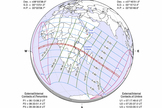This screengrab of the annular solar eclipse of May 9, 2013, shows the moment of the “ring of fire,” which was visible from parts of Australia. This online image is provided by the Coca-Cola Space Science Center in Columbus, Georgia.
A spectacular “ring of fire” solar eclipse will darken skies over Africa early Thursday morning (Sept. 1), and people anywhere in the world can watch the event live during a free webcast by the Slooh Community Observatory.
The show will feature live telescope shots from Slooh’s flagship observatory in the Canary Islands off the west coast of Africa, as well as views from South Africa, Tanzania, Madagascar and tiny Reunion Island. You can watch the webcast at Slooh.com , beginning at 2:45 a.m. EDT Thursday (0645 GMT).
You can also watch the solar eclipse webcast on Space.com , courtesy of Slooh. Thursday’s eclipse will begin a little after 2 a.m. EDT (0600 GMT), reach its maximum extent three hours later and wrap up at about 8 a.m. EDT (1200 GMT). [Solar Eclipse 2016 Guide: Where, When & How to See It ]
“We’re in for one heck of a ride as we follow the moon’s shadow as it races across the surface of the Earth at over 2,000 mph,” Slooh astronomer Paul Cox said in a statement. “We’ve got a terrific lineup of expert guests on the show — everything from the science of eclipses through to how they affect us psychologically, and a look at how mankind has treated these amazing celestial events in the past.”
In “ring of fire” (also known as “annular”) solar eclipses , the moon doesn’t quite blot out the sun, leaving a thin ring blazing around the edge of the solar disk. Such events occur when the moon is relatively far from Earth in its elliptical orbit. (Total solar eclipses occur when the moon is closer to Earth, and therefore big enough in our sky to block the sun completely.)

Map showing the path of the Sept. 1, 2016 annular solar eclipse across parts of Africa.
Credit: NASA/Fred Espenak
The ring effect will be visible Thursday only from a narrow band that cuts across the Atlantic Ocean, south-central Africa, parts of Madagascar, Reunion and the southern Indian Ocean. But most of Africa will be treated to a partial eclipse, as will parts of the Arabian Peninsula and slivers of Indonesia and Western Australia.
Thursday’s event is the second solar eclipse of 2016; the first was a total eclipse on March 8-9, which was visible from Indonesia and the Pacific Ocean region. Another annular solar eclipse, visible from parts of southern Chile, Argentina and Africa, will occur in February 2017. Then, on Aug. 21, 2017, a total solar eclipse will darken skies over a long stretch of the continental United States.
Warning: Never look directly at the sun, even during an eclipse, without proper eye protection; serious and permanent vision damage can result.
Viewers can ask questions and interact with the host and guests during Thursday’s eclipse show by tweeting @Slooh or by joining in on the live chat on Slooh.com .
Follow Mike Wall on Twitter @michaeldwall and Google+ . Follow us @Spacedotcom , Facebook or Google+ . Originally published on Space.com .
Comments are closed.